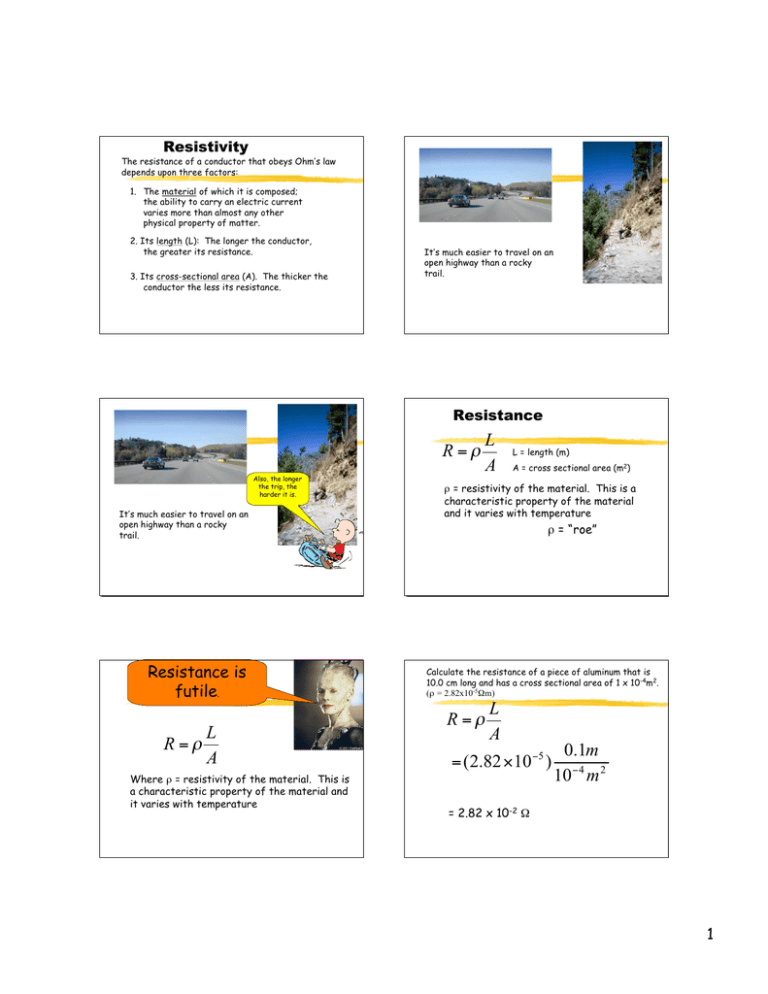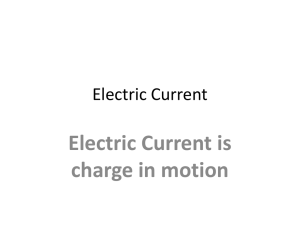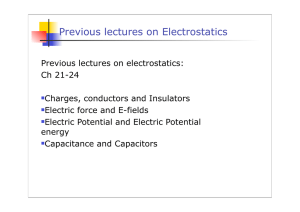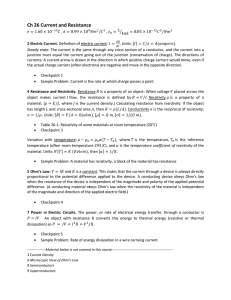Notes - Resistance Ch 17
advertisement

Resistivity The resistance of a conductor that obeys Ohm’s law depends upon three factors: 1. The material of which it is composed; the ability to carry an electric current varies more than almost any other physical property of matter. 2. Its length (L): The longer the conductor, the greater its resistance. 3. Its cross-sectional area (A). The thicker the conductor the less its resistance. It’s much easier to travel on an open highway than a rocky trail. Resistance R =! Also, the longer the trip, the harder it is. It’s much easier to travel on an open highway than a rocky trail. Resistance is futile. Resistance R =! L A Where ρ = resistivity of the material. This is a characteristic property of the material and it varies with temperature L A L = length (m) A = cross sectional area (m2) ρ = resistivity of the material. This is a characteristic property of the material and it varies with temperature ρ = “roe” Calculate the resistance of a piece of aluminum that is 10.0 cm long and has a cross sectional area of 1 x 10-4m2. (ρ = 2.82x10-5Ωm) R =! L A = (2.82 "10 !5 ) 0.1m 10 ! 4 m 2 = 2.82 x 10-2 Ω 1 Repeat the calculation for a piece of hard rubber… ρ = 1.0 x 1013Ωm R =! L A ΔR = αRΔT = (1"1013 ) 0.1m 10 ! 4 m 2 An alternative formula, used to calculate the resistance of a material at any temperature is given by…. ρ = ρo [1 + α(T-To)] In this equation, resistivity is referenced to some standard resistivity ρo at some standard temperature To In terms of resistance … R = Ro [1 + α(T – To)] Playing with Ohm’s Law… Volts x amps = Amps = Coulombs/second Joules/Coulomb x Coulombs/second = Joules/second Power = Volts x Amps Where α is the temperature coefficient of resistivity of the material. This is a characteristic property of the material. A negative coefficient indicates the resistivity decreases with increasing temperature. = 1.00 x 1016 Ω Volts = Joules/Coulomb The resistivities of nearly all substances vary with temperature. In general, metals increase in resistivity with an increase in temperature while non metals decrease in resistivity. = Watts Wait for the better equations Example: A metal wire has a resistance of 10.00 Ω at a temperature of 20oC. If the same wire has a resistance of 10.55 Ω at 90oC, what is the resistance of the wire when its temperature is -20oC? Step 1: find the temp. coefficient of resistivity, α R = Ro [1 + α(T – To )] 10.00 = 10.55[1 + α(20-90)] α = 7.857x10-4 Step 2: find the resistance at -20oC R = Ro [1 + α(T – To )] R = 10[1 + 7.857x10-4(-20-20)] = 9.68 Ω POWER P = VI But V = IR so…. P = I2 R P = VI 2 What is the current flow to a 1000W hairdryer plugged into a 120V socket? 1) 8.3A 2) 10A 3) 12.2A Ohm’s Law Equations: 4) 15.8A 5) 20A V = IR P = IV P = (V/R)V = V2/R P = V2/R Lets say you want to protect your new speakers by putting a fuse in line with the speakers. Assume you have 100W speakers and that they are 8 ohms. What size (amps) fuse should you use so that it just blows at 100 Watts? P = I2R 100W = Each mini-group needs: 1 battery I2 8 I2 = 100/8 = 12.5 I = 3.5 amp fuse 1 battery holder 2 wires 1 VERY small pinch of steel wool A fuse is used to prevent an appliance from receiving too much current. If the current goes through a fuse first and is too much for the fuse to handle, the fuse will burn up, protecting the appliance. Two light bulbs operate from 120V, but one has a power rating of 25W, and the other has a power rating of 100W. Which bulb has the higher resistance? 1) 25W bulb 2) 100W bulb 4) Depends on the bulb 3) Both the same 3





